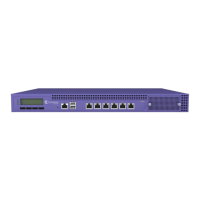Configuring RF Management
RF Management profiles are AP model dependent and reusable. Default profiles are intended to make
RF Management easy, getting you up and running without having to configure an RF policy. However,
you can always create additional profiles based o of default RF Management profiles. The RF
Management support is dependent on the AP model.
A Centralized site supports the following AP models:
•
AP39xx supporting ACS Policy for RF Management
•
AP5xx supporting Smart RF Policy for RF Management
Distributed sites support the following AP models, which support Smart RF Policy for RF Management:
•
AP5xx
•
AP76xx
•
AP8xxx
Related Links
Configuring ACS RF Policy on page 90
Configuring Smart RF Policy on page 91
Basic RF Management Settings
From the Basic tab, set the RF Management policy for both ACS and Smart RF. The following settings
are available for Smart RF only:
•
Sensitivity
•
Coverage Hole Recovery
Table 36: Basic RF Management Settings
Field Description
Name Name of the RF Management policy.
Sensitivity
Note: Available for Smart RF policy only.
Determines pre-defined thresholds for Smart RF. Valid values are:
•
Low — Interference recovery 30 dBm. Coverage Hole Recovery 20
dBm
•
Medium — Interference recovery 20 dBm. Coverage Hole Recovery
20 dBm
•
High — Interference recovery 5 dBm. Coverage Hole Recovery 20
dBm
•
Custom. Select Custom to modify Smart RF settings.
Note: If the sensitivity setting is too low, you may be tolerating
channel congestion, impacting network performance. If the
sensitivity setting is too high, you may have diculty finding an
optimal channel. The default Smart RF policy that is delivered with
ExtremeCloud Appliance is configured with Medium sensitivity.
Interference Recovery Determines optimum channel due to noise thresholds, client count and
other factors that influence channel switching algorithms. To avoid
channel flapping, a defined hold-timer disables interference avoidance
for a specific period of time upon detection. Interference Recovery is
enabled for the default Smart RF policy.
Configure
ExtremeCloud Appliance User Guide for version 4.36.03 87

